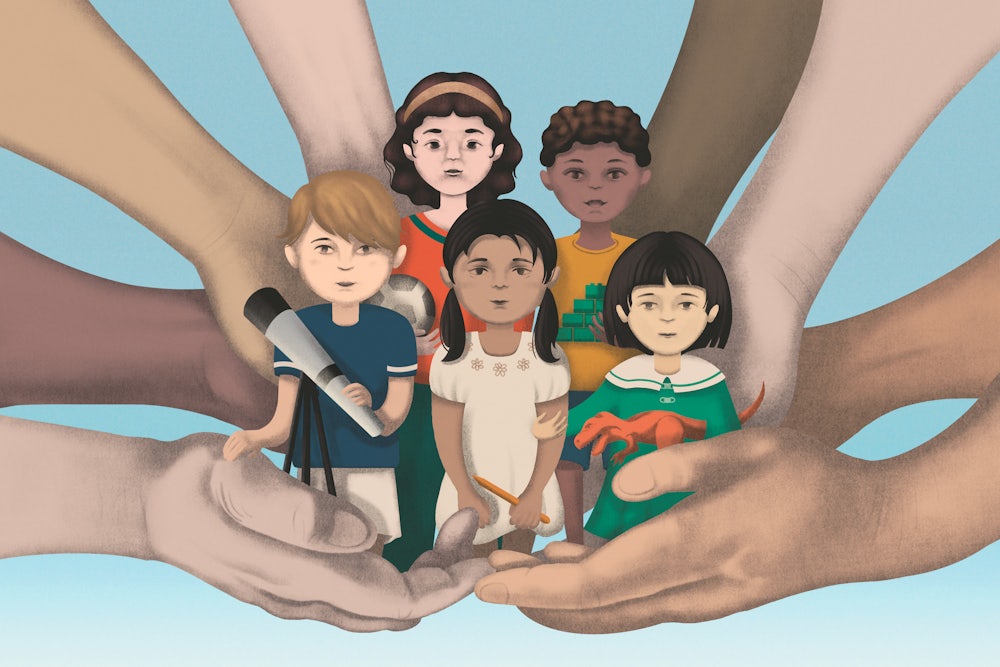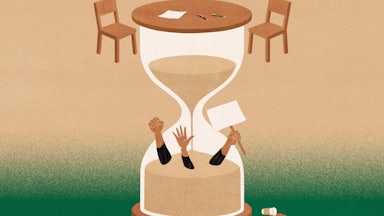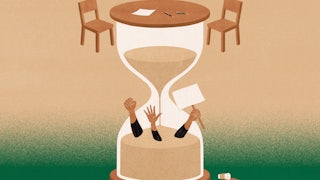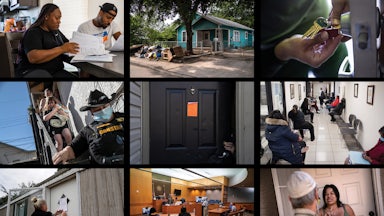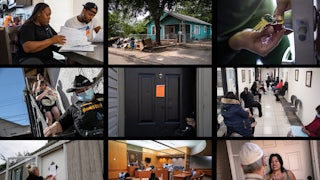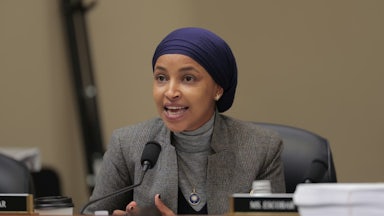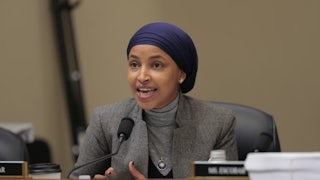Patricia Bustillos is a serious woman, her dark hair streaked with grey and her forehead lined with wrinkles; turquoise earrings hang from her earlobes. She is the matriarch of a household in New Mexico that includes her daughter and her daughter’s child, as well as her son and his wife and their child. They all struggle to work and pay the rent together.
Care for the youngest members of their family tended to cut into the available kitty. Before the pandemic, Bustillos’s daughter had to pay about $40 a week as a co-pay just to put her daughter in a daycare with a childcare subsidy. “Sería bastante caro,” she recalled: It was quite expensive. “Era muy, muy difícil pagar los copagos.” It was very, very difficult to pay the co-pays. Bustillos’s daughter-in-law couldn’t even afford a co-pay, so she didn’t work outside of the home.
But things have gotten far easier for their family in the past two years. In March 2021, Democrats passed the American Rescue Plan, which was signed into law by President Joe Biden. That measure included $39 billion for the childcare industry, including $15 billion worth of supplemental funding that states could use flexibly to meet the crisis. That April, New Mexico Governor Michelle Lujan Grisham announced that the state would use the money to waive co-payments for all families like Bustillos’s who received subsidies. At the same time, the state expanded eligibility for those subsidies to families earning up to 400 percent of the federal poverty line or, at the time, as much as $111,000 a year for a family of four, ensuring free childcare for 30,000 families. In essence, the state created something akin to universal, free childcare for nearly all residents.
The move was “in line with the governor’s vision,” said Elizabeth Groginsky, New Mexico’s Cabinet secretary for early childhood education, recalling how Grisham’s campaign made childcare one of its front-and-center issues. But ARP funding moved up the timeline, allowing her vision to be implemented sooner than projected. “The federal relief money allowed us to act on that more quickly.”
New Mexico is part of a massive new trend: During the pandemic, half of U.S. states waived co-payments and made childcare free for all families who received subsidies, something that had never been done outside of natural disasters, according to Karen Schulman, the director of state childcare policy at the National Women’s Law Center. In a country where the full cost of childcare can easily cost a family more than $10,000 a year, consuming more of its budget than housing or health care in many areas of the country, states took a radical step and zeroed out the cost entirely.
In total, 26 states waived co-pays for families that receive state assistance. Some managed to implement such a policy before the American Rescue Plan became law, but the funding spurred far more to join in: 15 implemented free care after the bill was signed, with a number explicitly using the bill’s discretionary grants to achieve the change. The states that decided to make childcare free are not just the blue-hued ones that already tend to be generous in childcare spending: They include Alaska, Georgia, Indiana, Maine, Mississippi, North and South Dakota, and Wyoming.
“We’ve seen over the years where red states and blue states have taken steps forward” on childcare policy, Schulman pointed out. “The question is always: Do they have the resources for it?” With money at their fingertips during the crisis, states of various political alignments recognized how important it would be for families to get free care. “States are willing to make those changes if they have the resources,” she said.
Schulman has tracked childcare policy at the state level for a long time. Typically, “it inches along but there are not big changes,” she said. Things were different in the pandemic. “This was a big thing.”
The elimination of co-pays was certainly a big deal for Patricia Bustillos. “Fue una gran ayuda,” she said: It was a huge help. Her son’s wife enrolled their daughter in a childcare center for the first time, which meant that she could go to work full time, allowing her to contribute to the family’s monthly rent. For Bustillos’s daughter, not having to pay a $40 co-pay meant more money for food, gas, and rent. Both daughters were able to pay for their own cars to take their own children to daycare and get back and forth to their jobs.
The stability has helped to open further doors for Bustillos. Having both grandchildren in childcare means she’s been called on less to care for the girls herself, freeing her up to work more. She’s putting more hours in at a nonprofit that offers parenting skills, working both morning and afternoons, while she spends the rest of her time cleaning offices. “Eso para mi es un ingreso extra,” she said: For me that’s extra income.
She’s also able to participate more in nonfinancial activities. She’s a member of OLÉ, a grassroots nonprofit that has advocated for more investment in childcare and early childhood education, and she traveled to the state Capitol to lobby for investment without worrying about having to care for her grandchildren. She also participated in a training with the nonprofit National Women’s Law Center to do public speaking about social justice and equal pay for women, especially Latinas like her. The NWLC has taught her “como cuidar a yo” and “como relajarme”: how to take care of herself and relax.
She is “menos preocupada,” less worried, she said. She’s able to be less stressed out, to do her work more calmly.
Then there are the benefits for the children themselves. At daycare, her granddaughters are gaining new vocabulary and learning the colors, the alphabet, and numbers. They’re learning how to behave themselves and now have a daily routine in which they seem to be thriving. When Bustillos drives them to the park or the ice cream store, she hears them talking to each other in the back much more than they did before daycare. One child can count in both Spanish and English.
Bustillos is one of many people in the state who have had their horizons widened thanks to free childcare. The state’s childcare assistance program is serving more people each month than it ever has before, and 87 percent of families reported that it had a positive impact on their well-being.
People have had “a little bit more breathing room in their lives,” said Miles Tokunow, deputy director of OLÉ. He’s heard from many who were able to enter the workforce, while others were able to focus on how to advance in their work and even switch careers. A number of people have said that free childcare allowed them to flee dangerous situations, such as domestic violence or sexual abuse. “It’s been a huge deal,” he said.
Covering a co-pay is, of course, cheaper than paying the full cost of care on the private market. But for the low-income families who typically qualify for help, even paying a small amount can take a huge bite out of their budget. “For families who are just scraping by, every dollar counts,” Schulman pointed out. And for many it wasn’t just a few dollars—co-pays can reach into the hundreds of dollars a month. “It just makes a huge difference.”
Free childcare hasn’t just been a godsend to parents and families, though. It’s also benefited childcare providers. In some states, providers were previously expected to collect co-pays themselves; when they couldn’t, they often had to absorb the cost. With co-pays waived, states are simply paying that extra amount directly to providers. That has helped New Mexico childcare and early education providers “focus on the children,” Tokunow said. No longer do they have to discuss co-payments and paperwork with parents at pickup; they can instead focus on children’s development.
Providers have seen other benefits as well. Ivydel Natachu, who has worked in a daycare in New Mexico for 15 years, said free childcare “brought in more families that really needed it.” Previously, many of those families didn’t qualify for subsidies and would have had to pay out of pocket, which put childcare out of reach. Now they can finally get care.
The new families that enrolled have stayed with her program, particularly after realizing how enriching the care is. Some parents assumed that “daycare” meant just putting the kids in front of movies. That’s nothing like what her program offers: “We follow curriculum, doing lesson plans, we’re observing [the children] to make sure they’re meeting their milestones,” she said. “Noticing how their child was developing and learning, that made them stay.” Some have told her that, even if the co-pays come back, they’ll find a way to keep their children at the center.
“It feels good as a childcare worker, as an educator, to get recognized,” she said. “We gained a little more respect from the community.”
For families who enrolled and started sending their children to the center where Natachu works, the free care meant they were able to go back to work or school, they could save more of their money, and they had an easier time buying food and paying bills. Some even talked about being able to fix up their houses, she said.
All of these positive benefits are now at risk of disappearing. American Rescue Plan funding expired at the end of September, so states are now facing the choice of trying to hold onto policies like waiving co-pays with their own money or ending them. As of May, all of the states that started waiving co-pays after the bill was passed planned to end the policy before the end of this year.
That’s not to say that nothing has changed. The experience has left a lasting impression on some states, which saw what it meant to lift the burden of co-payments from families and providers. Some took the opportunity to permanently change their co-payment schedules moving forward so that families will face lower costs. The Biden administration also proposed new rules in July that would encourage states and explicitly give them the authority to waive co-payments for families earning 150 percent of the federal poverty level or less. But, as Schulman pointed out, “it costs money.” States can’t just be given permission to waive co-payments; they need funding to do it. “Otherwise you’re going to have to cut back in other areas or the burdens will be moved elsewhere,” she said.
The pandemic led to an “increased recognition of the importance of childcare and more commitment to it,” Schulman said. But truly long-term, transformational change has yet to follow.
New Mexico hasn’t ended free and expanded childcare, but it’s now on a fragile footing. While the state maintains that it’s going to continue waiving co-pays—and Groginsky vowed that it would continue during the governor’s tenure, which lasts through the end of 2026—it’s no longer covered by ARP funding. Instead, it’s now up to the legislature to come up with the money. State lawmakers committed $100 million for fiscal year 2024, and the governor has asked for another $80 million to continue waiving co-pays for parents and keep the expanded eligibility in place, as well as other related initiatives. The state is in a better situation than most: Last November, voters approved a constitutional amendment that ensures a steady stream of about $150 million a year for childcare and early childhood education.
But Bustillos fears that the legislature will decide to bring co-pays back. If that happens, her son’s wife would have to stop working, which would mean more of the rent and household bills will fall on Bustillos. Bustillos’s daughter is pregnant and due in March, and she worries that, due to the expense of childcare, she will be called on more to help care for the new baby and her granddaughter. That would mean that the goals she’s set for herself would end up on the back burner. She has been hoping to travel to Mexico to see family for the first time in years.
She also wants to prepare for that time in her life when she won’t be able to work by accumulating some savings for retirement—which would be difficult if her family had to start paying for childcare again or if she had to care for her grandchildren more and work for pay less. “Va a ser un impacto muy fuerte,” she said. If the co-pays come back, it’s going to have a very strong impact on her family.
The state has, at the very least, committed to giving residents three months’ notice if cost or eligibility policies change. The state has also changed its co-payment schedule so that no family making 185 percent of the federal poverty line or less will face a co-pay, while all others won’t have to pay more than 5 percent of their gross income.
Still, residents are concerned. “We’re still fighting for the free childcare,” Natachu said. She and other organizers are eager for the next legislative session to begin in January so they can convince lawmakers to ensure “permanent, free daycare and free childcare.” Without it, she fears that families will pull their children out of childcare and a lot of providers will end up out of work.
The state “just proved how successful, wildly successful, and important this policy is,” Tokunow said. “Now let’s make sure it continues. That’s the fight that we’re in.”
Reporting for this article was supported by New America Foundation’s Better Life Lab.
